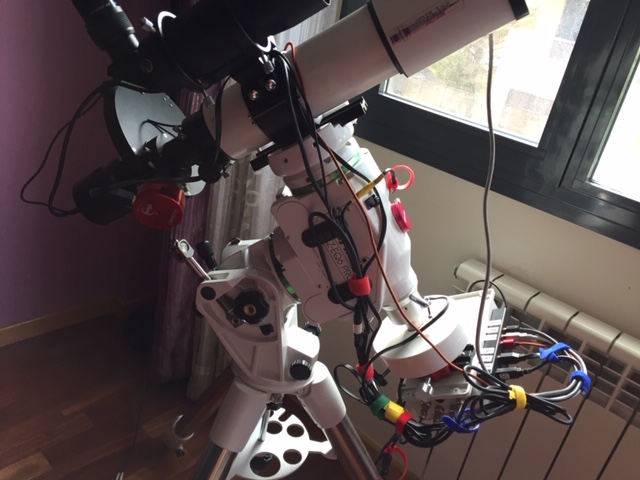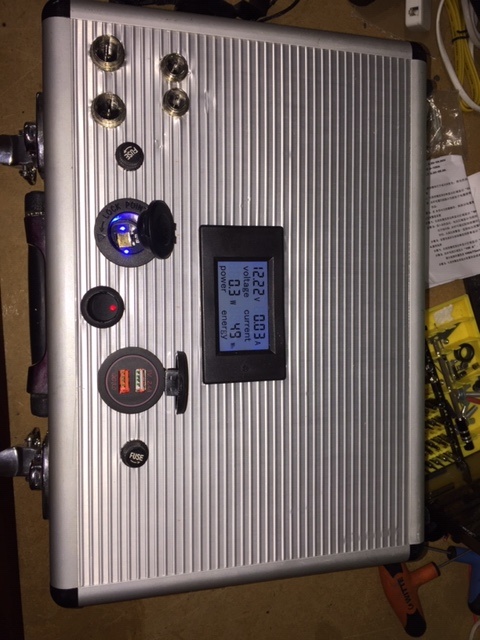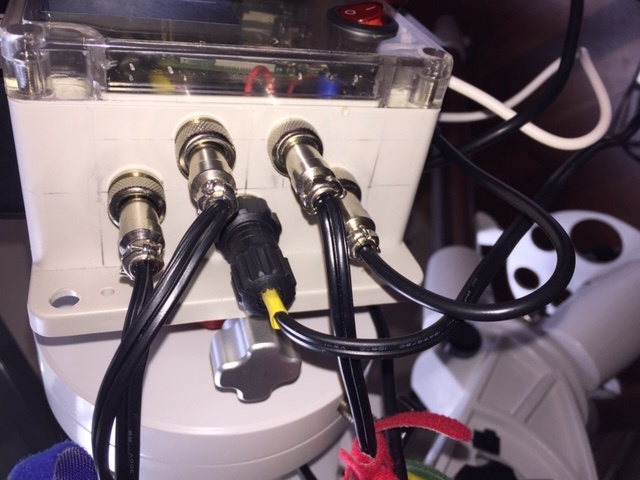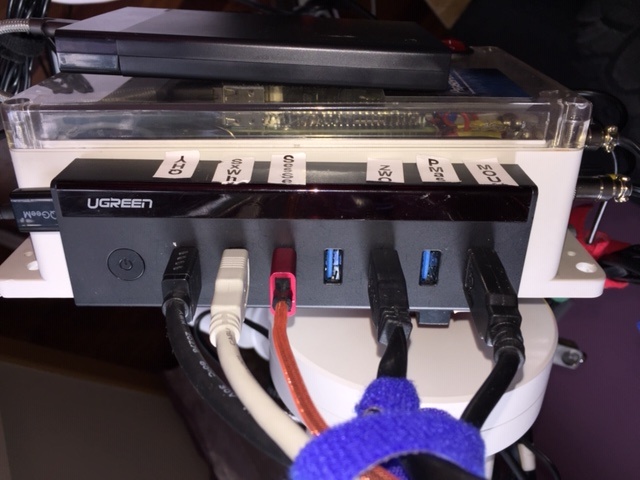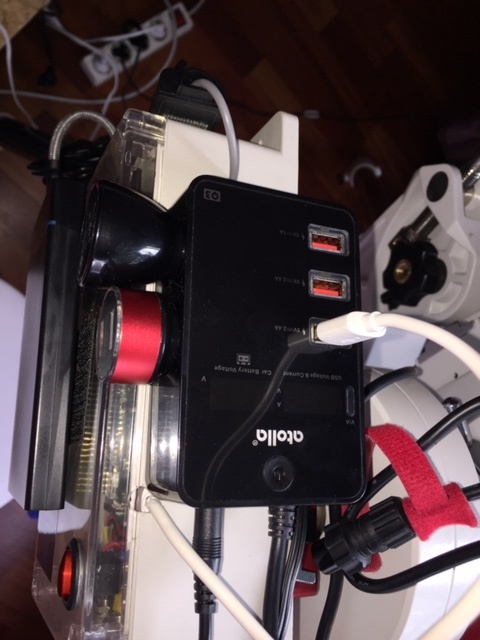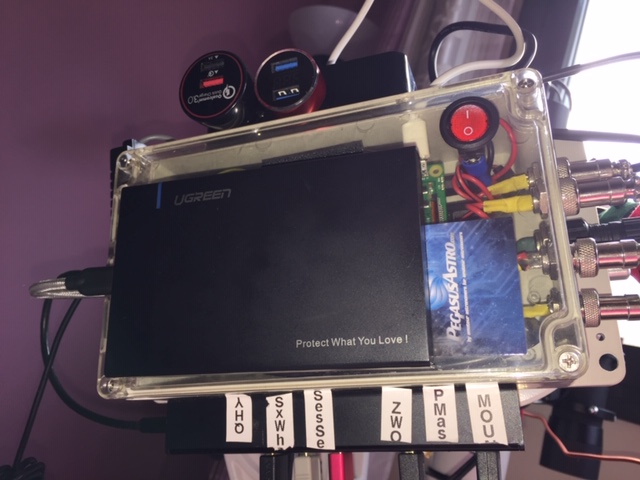Francisco Labrador replied to the topic 'what devices are you running KStars on?' in the forum.
5 years ago
Hi all!
This is my gear... and my story...
I've been fighting against SM on RPI for months. Maybe that I am not a Linux expert, maybe delays on receiving some items, maybe some of them were too n"ew fashioned", maybe I had not enough time to dedicate to it...
Jasem has been an excellent support for me (I hope that he wants continue being it...) despite the fact that I was about to resign more than once...
But here I am and this is my gear. Up and running (almost). And this has been my experience...
First, a picture:
This is my TMB 40/480 mounted on a SW AZEQ6-Pro. Image train consist of a QHY183M (cooled mono) + SX Filter Wheel + ZWO OAG + ZWO ASI290MC. Focuser is a Sesto Senso.
The mess in the counterweight shaft is the electronics that govern all this invention.
I decided to install it so because this way the only cable that goes “outside” of the telescope-mount assembly is the one that powers all devices.
A closer view:
Breaking it down:
External Power (for mobile use):
This is no more than two Lead Gel batteries inside a cheap tools case.
One of them is a 12v 17Ah connected to the ligther outlet and the GX12 & GX16 connectors and the other is a 12V 7.2Ah connected to the USB outlet. This USB give 5v 5.4A total with a slot with 2.4A and the other with 3A. Good power!
The little panel shows voltage, current, power and total energy consumed per session.
All this stuff came from Aliexpress as real bargains… but works perfect!
Whether somebody are interested on some of them, I will be happy to share the links to buy them.
These are the external connections of my also homemade control unit.
One GX16 input connector and four GX12 output connectors.
The heart of the power management is a Pegasus Astro Pocket Power Box (PPB):
pegasusastro.com/products/pocket-powerbox/
Very interesting little appliance. I preferred this to its big brother UPB because I think that this second one doesn’t justify the cost…
Of course, it has INDI driver available and after some initial issues, Jasem and Pegasus Astro’s staff solved it without major problem. Thanks so much to both!!
On the opposite side of the box, there are some outlets for Dew strips and a 8v port to power almost any DLSR camera. These ports are also feed by PPB:
Data stuff:
Powered USB 3.0 hub purchased from Amazon for a few bucks. 7 ports and works fine.
I labeled the ports because is more than useful to hardware map all devices in Ekos. Too much devices, but they are really well managed by Ekos/INDI/Serial Port Manager.
I have not had any problem with it even unpowered as my RPI is powered by this device below, that can supply 5.02v at 2.4A. From Aliexpress:
This is no more than a 12v powered device with 3 USB ports @2.4A each. I have attached a GX16 input connector and also has a 5.5x2.1 input for another external power source.
One of the USB ports supplies power to the RPI that is also inside the box.
In my experience 2.4A are good enough to keep all running.
Also has two car lighter style general purpose outlets. I have put a couple of adapters to get additional USB power if needed but can be used for anything you want (except for a car lighter… ironic…)
I have also tried some BEC (Battery Eliminator Circuit) that I also use for my plane models. This has commonly a 5v or 5.5v output and supports any input voltage between 7.4 and 22.2v. Usually they support currents by 3A or so on and provide a very stable, accurate and almost noise free current. Very versatile devices for some applications, cheap and small.
On top of the box a 500Gb SSD drive made by Crucial and purchased to Amazon, inside of a Ugreen external case also from Amazon:
Some considerations that I have found relevant:
- The four USB 2.0 ports supports (hardware mapped into Ekos/INDI):
o PPB
o GPS
o SSD
o External HUB
I have tested lots of different configurations with these ports including cameras, filter wheels, focusers… and I found that this is the one that gives me the best results. I don’t know why, but this is a fact. On top of that, it’s preferable that all “removable” devices are installed externally by obvious reasons.
- Hardware mapping of ALL devices is a must. If not, it’s really crazy to make it all work together.
- SD Card has to be a good quality one. A must, one more time. Don’t be “Mr. Scrooge” with this. You will find a huge difference in performance and reliability. Mine is a Sandisk A2, up to 160 MB/s, Class 10, U3 and V30.
- I have also installed a RealVNC server for remote access. In my experience it has two benefits over the X11 server already installed:
o Simple to install (but somehow tricky)
o Allows real remote access from Internet and is for free.
o I have not had any problem with ampglow even though my connection to the camera is an USB 2.0 port. I think that this is due to the effectiveness of the camera buffer.
QHY183M camera resolution is really high (5544x3684, 20Mpx, resulting in near 40Mb size for each FITS take) but I tried more than one sequence of 180 seconds exposure by take, 10 takes by filter (7) and I didn’t find any delay at all.
It’s true that downloading a single picture can take 10 secs or even more but due to buffer action, camera starts taking the next picture without having to wait for disk download. This way, a sequence is performed seamless and without any ampglow, noise, delay nor anything issue else. By the way I download all FITS images directly to the external SSD so that I only have to mount it into my Mac or PC to be processed.
To operate all my gear I use to use a MacBook Air (2015) or an Intel PC (built by me). Sometimes an old iPad Mini, but this is not very practical due to the size… My eyes are not what used to be… Always through Real VNC access and the embedded stellarmate hotspot.
The system performs very well this way. I have not found any significant improvement by using ethernet (seriously), so less cables, less mess…
I have tried to run Kstars from both PC or Mac and remotely attack the RPI performing very well, but GUI of these applications is not so fine to me… I have problems setting screen resolutions (for instance and among other issues) and sometimes they have an erratic behavior. I will keep investigating but I prefer indeed reliability when in the field than speed. Once at night and under the stars, is not a matter of time in my humble opinion.
In summary, I am very happy with Stellarmate over RPI. It’s cheap, reliable, performs well, simple, small, with excellent support (thanks community!) designed to support tons of different devices or your choice, based on good enough standards. I think sincerely that the little improvement that other systems could provide don’t compensate the huge cost that these electronic devices sometimes have. I absolutely prefer to spend my scarce money in better optics and mechanical components. At the end of the day, if you don’t have the best lenses, mount and cameras that you can pay (this is, again, my opinion and my experience) there won’t be electronics that can amend a poor quality light or poor quality tracking, for instance.
My pleasure to share my thoughts with the community. Miguel de Cervantes (I am spanish) said “there is no book so bad that he cannot get some teaching”. I hope that maybe could be at least a little help for somebody.
Read More...
© 2003-2022 by INDI Library. All rights reserved.


